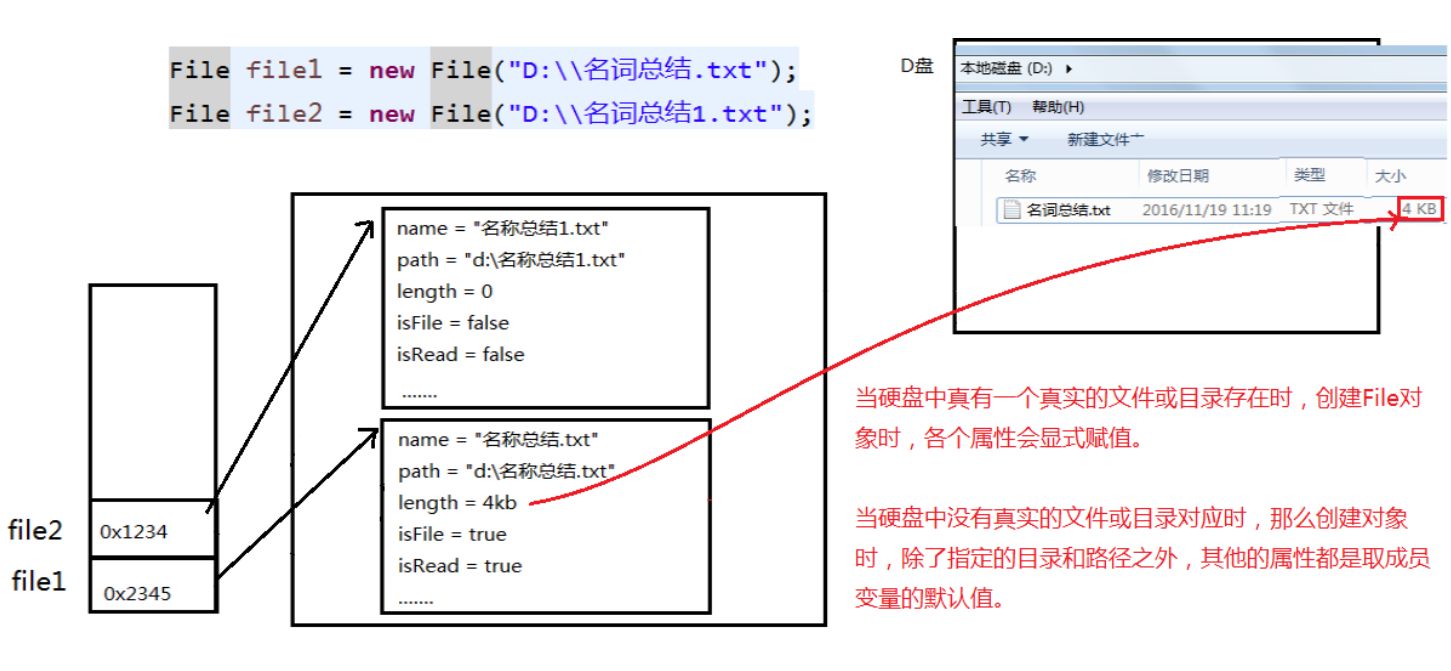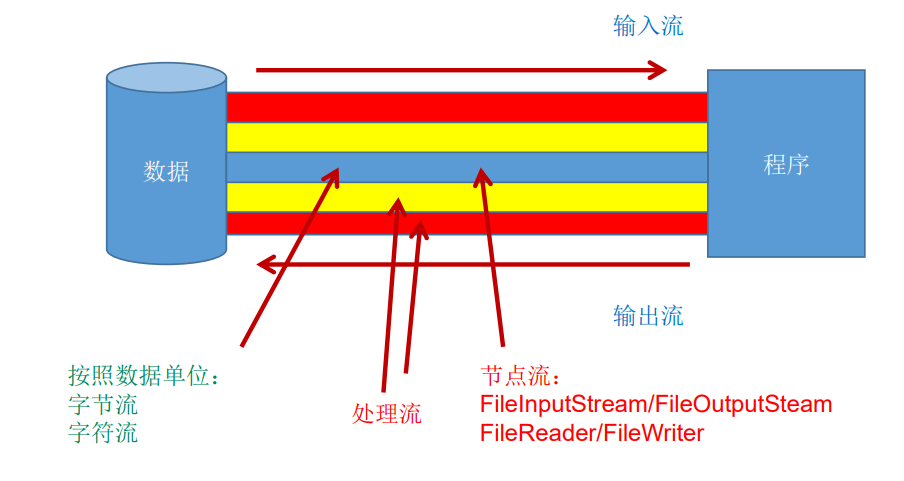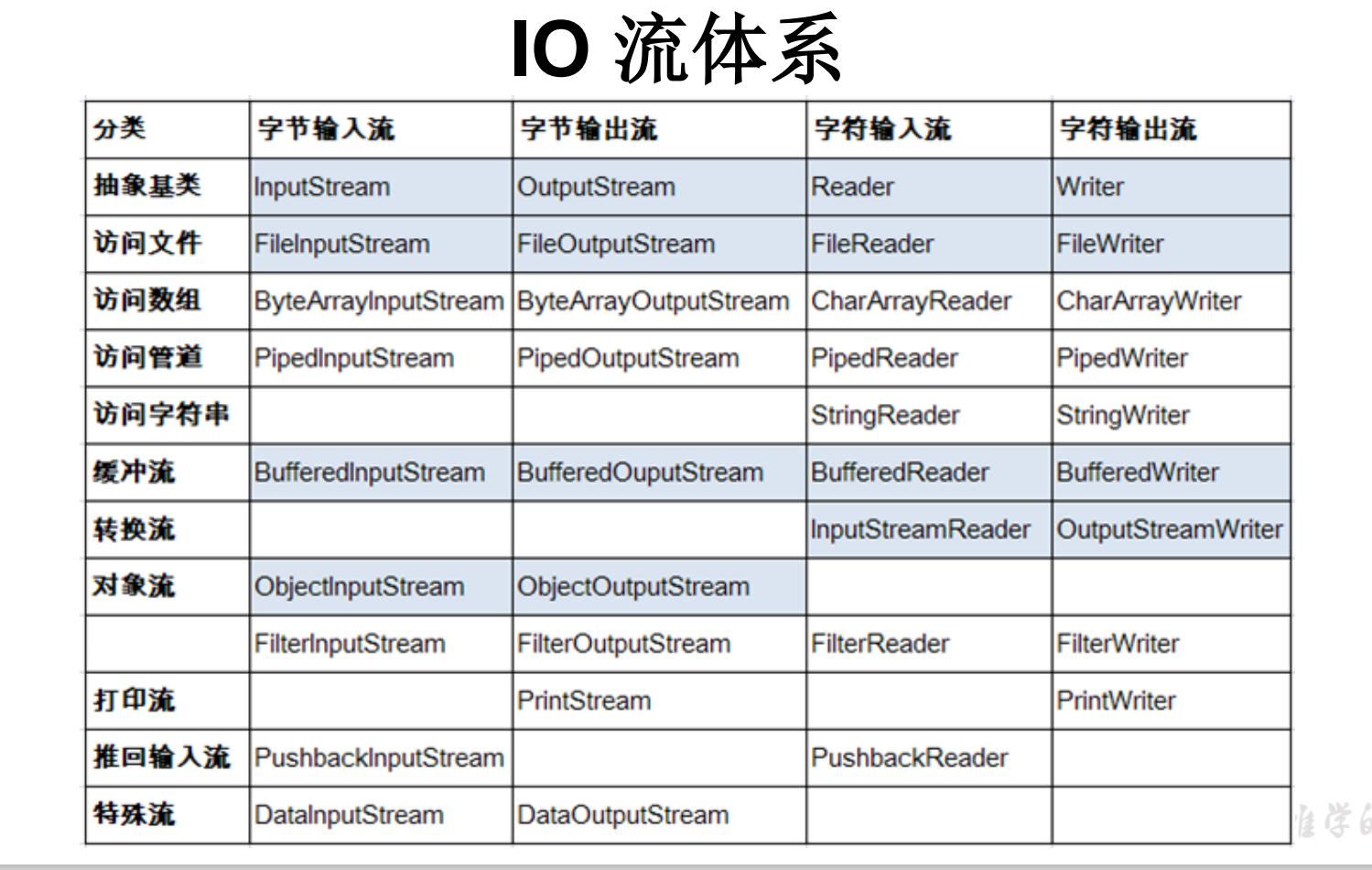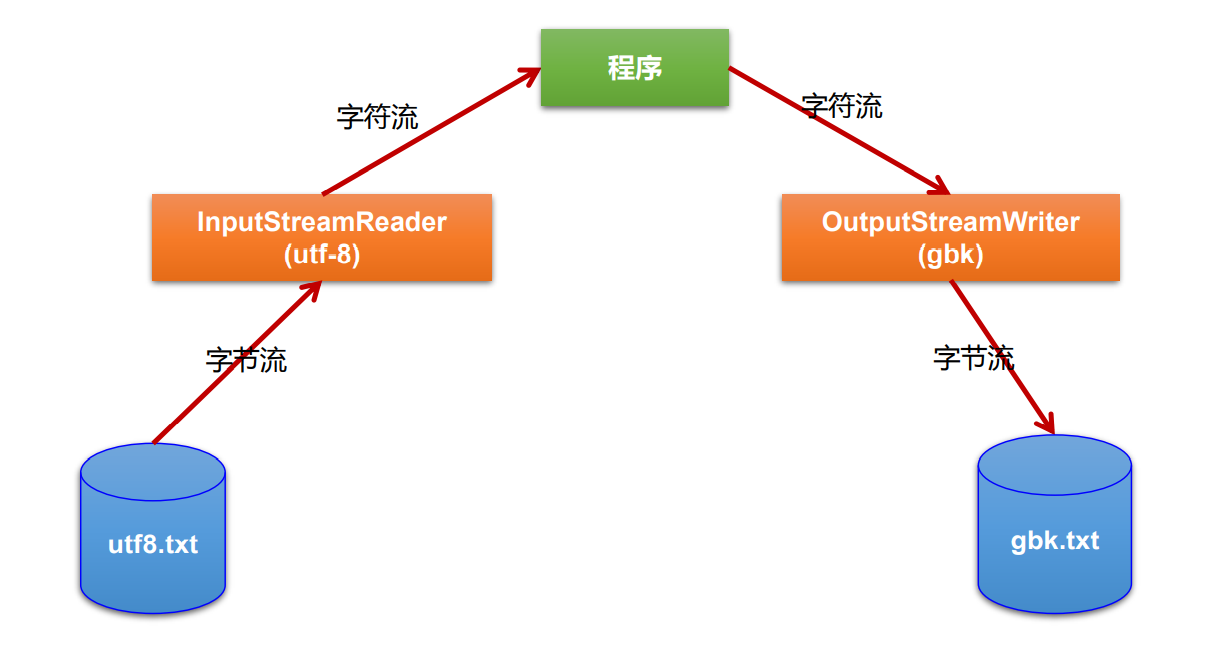JavaIO流
一、File类的使用
1.1 File类的概述
-
java.io.File类:文件和文件目录路径的抽象表示形式,与平台无关。
-
File 能新建、删除、重命名文件和目录,但 File 不能访问文件内容本身。如果需要访问文件内容本身,则需要使用输入/输出流。
-
想要在Java程序中表示一个真实存在的文件或目录,那么必须有一个File对 象,但是Java程序中的一个File对象,可能没有一个真实存在的文件或目录。
-
File类的对象可以作为参数传递给流的构造器
1.2 File类的常用构造器
-
public File(String pathname)
以pathname为路径创建File对象,可以是绝对路径或者相对路径,如果pathname是相对路径,则默认的当前路径在系统属性user.dir中存储。
-
绝对路径:是一个固定的路径,从盘符开始
-
相对路径:是相对于某个位置开始
IDEA中:
使用Junit中的单元测试方法测试,相对路径即为当前Module下,
使用main()方法测试,相对路径即为当前的Project下。
-
-
public File(String parent,String child)
以parent为父路径,child为子路径创建File对象。
-
public File(File parent,String child)
根据一个父File对象和子文件路径创建File对象
1.3 File类的路径分隔符
-
路径中的每级目录之间用一个路径分隔符隔开。
-
路径分隔符和系统有关:
-
windows和DOS系统默认使用“\”来表示
-
UNIX和URL使用“/”来表示
-
-
Java程序支持跨平台运行,因此路径分隔符要慎用。
-
为了解决这个隐患,File类提供了一个常量:
public static final String separator :根据操作系统,动态的提供分隔符。
举例:
//windows和DOS系统默认使用“\”来表示 File file1 = new File("d:\\zzz\\info.txt"); //UNIX和URL使用“/”来表示 File file2 = new File("d:/zzz/info.txt"); //根据操作系统,动态的提供分隔符。 File file3 = new File("d:" + File.separator + "zzz" + File.separator + "info.txt");
1.4 File类的常用方法
-
File类的获取功能
-
public String getAbsolutePath():获取绝对路径
-
public String getPath() :获取路径
-
public String getName() :获取名称
-
public String getParent():获取上层文件目录路径。若无,返回null
-
public long length() :获取文件长度(即:字节数)。不能获取目录的长度
-
public long lastModified() :获取最后一次的修改时间,毫秒值
如下两个方法适用于文件目录:
-
public String[] list() :获取指定目录下的所有文件或者文件目录的名称数组
-
public File[] listFiles() :获取指定目录下的所有文件或者文件目录的File数组
-
-
File类的重命名功能
-
public boolean renameTo(File dest):把文件重命名为指定的文件路径
//比如:file1.renameTo(file2)为例: //要想保证返回true,需要file1在硬盘中是存在的,且file2不能在硬盘中存在。 @Test public void test4(){ File file1 = new File("hello.txt"); File file2 = new File("D:\\io\\hi.txt"); boolean renameTo = file2.renameTo(file1); System.out.println(renameTo);//false }
-
-
File类的判断功能
-
public boolean isDirectory():判断是否是文件目录
-
public boolean isFile() :判断是否是文件
-
public boolean exists() :判断是否存在
-
public boolean canRead() :判断是否可读
-
public boolean canWrite() :判断是否可写
-
public boolean isHidden() :判断是否隐藏
-
-
File类的创建功能
-
public boolean createNewFile() :创建文件。若文件存在,则不创建,返回false
-
public boolean mkdir() :创建文件目录。如果此文件目录存在,就不创建了。如果此文件目录的上层目录不存在,也不创建。
-
public boolean mkdirs() :创建文件目录。如果上层文件目录不存在,一并创建
注意事项:如果你创建文件或者文件目录没有写盘符路径,那么,默认在项目路径下。
-
-
File类的删除功能
- public boolean delete():删除文件或者文件夹
删除注意事项:
Java中的删除不走回收站。 要删除一个文件目录,请注意该文件目录内不能包含文件或者文件目录。

二、IO流原理及流的分类
2.1 Java IO原理
-
I/O是Input/Output的缩写, I/O技术是非常实用的技术,用于 处理设备之间的数据传输。如读/写文件,网络通讯等。
-
Java程序中,对于数据的输入/输出操作以“流(stream)” 的 方式进行。
-
java.io包下提供了各种“流”类和接口,用以获取不同种类的 数据,并通过标准的方法输入或输出数据。
-
输入input:读取外部数据(磁 盘、光盘等存储设备的数据)到 程序(内存)中。
-
输出output:将程序(内存) 数据输出到磁盘、光盘等存储设 备中。
2.2 流的分类
-
按操作数据单位不同分为:字节流(8 bit),字符流(16 bit)
- 字节流(byte)-->传输图片、视频
- 字符流(char)-->传输文本
-
按数据流的流向不同分为:输入流,输出流
-
按流的角色的不同分为:节点流,处理流
- 节点流:直接从数据源或目的地读写数据
- 处理流:不直接连接到数据源或目的地,而是“连接”在已存 在的流(节点流或处理流)之上,通过对数据的处理为程序提 供更为强大的读写功能。

2.3 四个抽象基类
2.3.1 四个抽象基类概述
-
Java的IO流共涉及40多个类,实际上非常规则,都是从如下4个抽象基类派生的。
-
由这四个类派生出来的子类名称都是以其父类名作为子类名后缀。
| (抽象基类) | 字节流 | 字符流 |
|---|---|---|
| 输入流 | InputStream | Reader |
| 输出流 | OutputStream | Writer |

重点掌握::⭐
| 抽象基类 | 节点流(或文件流) | 缓冲流(处理流的一种) |
|---|---|---|
| InputStream | FileInputStream (read(byte[] buffer)) | BufferedInputStream (read(byte[] buffer)) |
| OutputStream | FileOutputStream (write(byte[] buffer,0,len) | BufferedOutputStream (write(byte[] buffer,0,len) / flush() |
| Reader | FileReader (read(char[] cbuf)) | BufferedReader (read(char[] cbuf) / readLine() |
| Writer | FileWriter (write(char[] cbuf,0,len) | BufferedWriter (write(char[] cbuf,0,len) / flush() |
2.3.2 InputStream & Reader
- InputStream 和 Reader 是所有输入流的基类。
- InputStream(典型实现:FileInputStream)
- int read() :从输入流中读取数据的下一个字节。返回 0 到 255 范围内的 int 字节值。如果因 为已经到达流末尾而没有可用的字节,则返回值 -1。
- int read(byte[] b) :从此输入流中将最多 b.length 个字节的数据读入一个 byte 数组中。如果因为已 经到达流末尾而没有可用的字节,则返回值 -1。否则以整数形式返回实际读取 的字节数。
- int read(byte[] b, int off, int len) :将输入流中最多 len 个数据字节读入 byte 数组。尝试读取 len 个字节,但读取 的字节也可能小于该值。以整数形式返回实际读取的字节数。如果因为流位于 文件末尾而没有可用的字节,则返回值 -1。
- public void close() throws IOException:关闭此输入流并释放与该流关联的所有系统资源。
- Reader(典型实现:FileReader)
- int read() :读取单个字符。作为整数读取的字符,范围在 0 到 65535 之间 (0x00-0xffff)(2个 字节的Unicode码),如果已到达流的末尾,则返回 -1
- int read(char [] cbuf) :将字符读入数组。如果已到达流的末尾,则返回 -1。否则返回本次读取的字符数。
- int read(char [] cbuf, int off, int len):将字符读入数组的某一部分。存到数组cbuf中,从off处开始存储,最多读len个字 符。如果已到达流的末尾,则返回 -1。否则返回本次读取的字符数。
- public void close() throws IOException:关闭此输入流并释放与该流关联的所有系统资源。
- 程序中打开的文件 IO 资源不属于内存里的资源,垃圾回收机制无法回收该资 源,所以应该显式关闭文件 IO 资源。
- FileInputStream 从文件系统中的某个文件中获得输入字节。FileInputStream 用于读取非文本数据之类的原始字节流。要读取字符流,需要使用 FileReader
2.3.3 OutputStream & Writer
- OutputStream 和 Writer是所有输出类的基类。
- OutputStream
- void write(int b) :将指定的字节写入此输出流。write 的常规协定是:向输出流写入一个字节。要写 入的字节是参数 b 的八个低位。b 的 24 个高位将被忽略。 即写入0~255范围的。
- void write(byte[] b):将 b.length 个字节从指定的 byte 数组写入此输出流。write(b) 的常规协定是:应该 与调用 write(b, 0, b.length) 的效果完全相同。
- void write(byte[] b,int off,int len):将指定 byte 数组中从偏移量 off 开始的 len 个字节写入此输出流。
- public void flush()throws IOException 刷新此输出流并强制写出所有缓冲的输出字节,调用此方法指示应将这些字节立 即写入它们预期的目标。
- public void close() throws IOException :关闭此输出流并释放与该流关联的所有系统资源。
- Writer
- void write(int c) :写入单个字符。要写入的字符包含在给定整数值的 16 个低位中,16 高位被忽略。 即 写入0 到 65535 之间的Unicode码。 void write(char[] cbuf) 写入字符数组。
- void write(char[] cbuf,int off,int len) :写入字符数组的某一部分。从off开始,写入len个字符
- void write(String str) :写入字符串。
- void write(String str,int off,int len) :写入字符串的某一部分。
- void flush() :刷新该流的缓冲,则立即将它们写入预期目标。
- public void close() throws IOException :关闭此输出流并释放与该流关联的所有系统资源。
- 因为字符流直接以字符作为操作单位,所以 Writer 可以用字符串来替换字符数组, 即以 String 对象作为参数
- void write(String str);
- void write(String str, int off, int len);
- FileOutputStream 从文件系统中的某个文件中获得输出字节。FileOutputStream 用于写出非文本数据之类的原始字节流。要写出字符流,需要使用 FileWriter
2.4 节点流(文件流)
- 对于文本文件(.txt,.java,.c,.cpp),使用字符流处理
- 对于非文本文件(.jpg,.mp3,.mp4,.avi,.doc,.ppt,...),使用字节流处理
2.4.1 FileReader的使用举例
-
read()的理解:返回读入的一个字符。如果达到文件末尾,返回-1
-
异常的处理:为了保证流资源一定可以执行关闭操作。需要使用try-catch-finally处理
-
读入的文件一定要存在,否则就会报FileNotFoundException。
//将hello.txt文件内容读入程序中,并输出到控制台
@Test
public void testFileReader() {
FileReader fr = null;
try {
//1.实例化File类的对象,指明要操作的文件
File file = new File("hello.txt");//相较于当前Module
//2.提供具体的流
fr = new FileReader(file);
//3.数据的读入
//read():返回读入的一个字符。如果达到文件末尾,返回-1
//方式一:
//int data = fr.read();
//while(data != -1){
//System.out.print((char)data);
//data = fr.read();
//}
//方式二:语法上针对于方式一的修改
int data;
while ((data = fr.read()) != -1) {
System.out.print((char) data);
}
} catch (IOException e) {
e.printStackTrace();
} finally {
//4.流的关闭操作
//try {
// if(fr != null)
// fr.close();
//} catch (IOException e) {
// e.printStackTrace();
//}
//或
if (fr != null) {
try {
fr.close();
} catch (IOException e) {
e.printStackTrace();
}
}
}
}
//对read()操作升级:使用read的重载方法
@Test
public void testFileReader1() {
FileReader fr = null;
try {
//1.File类的实例化
File file = new File("hello.txt");
//2.FileReader流的实例化
fr = new FileReader(file);
//3.读入的操作
//read(char[] cbuf):返回每次读入cbuf数组中的字符的个数。如果达到文件末尾,返回-1
char[] cbuf = new char[5];
int len;
while ((len = fr.read(cbuf)) != -1) {
//方式一:
//错误的写法
//for(int i = 0;i < cbuf.length;i++){
// System.out.print(cbuf[i]);
//}
//正确的写法
//for(int i = 0;i < len;i++){
// System.out.print(cbuf[i]);
//}
//方式二:
//错误的写法,对应着方式一的错误的写法
//String str = new String(cbuf);
//System.out.print(str);
//正确的写法
String str = new String(cbuf, 0, len);
System.out.print(str);
}
} catch (IOException e) {
e.printStackTrace();
} finally {
if (fr != null) {
//4.资源的关闭
try {
fr.close();
} catch (IOException e) {
e.printStackTrace();
}
}
}
}
2.4.2 FileWriter的使用举例
-
输出操作,对应的File可以不存在的,并不会报异常。
-
File对应的硬盘中的文件如果不存在,在输出的过程中,会自动创建此文件。
File对应的硬盘中的文件如果存在:- 如果流使用的构造器是:FileWriter(file,false) / FileWriter(file): 对原有文件的覆盖。
- 如果流使用的构造器是:FileWriter(file,true): 不会对原有文件覆盖,而是在原有文件基础上追加内容。
@Test
public void testFileWriter() {
FileWriter fw = null;
try {
//1.提供File类的对象,指明写出到的文件
File file = new File("hello1.txt");
//2.提供FileWriter的对象,用于数据的写出
fw = new FileWriter(file, false);
//3.写出的操作
fw.write("I have a dream!\n");
fw.write("you need to have a dream!");
} catch (IOException e) {
e.printStackTrace();
} finally {
//4.流资源的关闭
if (fw != null) {
try {
fw.close();
} catch (IOException e) {
e.printStackTrace();
}
}
}
}
- 读入+写出 举例
@Test
public void testFileReaderFileWriter() {
FileReader fr = null;
FileWriter fw = null;
try {
//1.创建File类的对象,指明读入和写出的文件
File srcFile = new File("hello.txt");
File destFile = new File("hello2.txt");
//不能使用字符流来处理图片等字节数据
//File srcFile = new File("爱情与友情.jpg");
//File destFile = new File("爱情与友情1.jpg");
//2.创建输入流和输出流的对象
fr = new FileReader(srcFile);
fw = new FileWriter(destFile);
//3.数据的读入和写出操作
char[] cbuf = new char[5];
int len;//记录每次读入到cbuf数组中的字符的个数
while ((len = fr.read(cbuf)) != -1) {
//每次写出len个字符
fw.write(cbuf, 0, len);
}
} catch (IOException e) {
e.printStackTrace();
} finally {
//4.关闭流资源
//方式一:
// try {
// if(fw != null)
// fw.close();
// } catch (IOException e) {
// e.printStackTrace();
// }finally{
// try {
// if(fr != null)
// fr.close();
// } catch (IOException e) {
// e.printStackTrace();
// }
// }
//方式二:并不会因为fw出现异常而导致fr无法关闭,因为try-catch已经把已经解决了
try {
if (fw != null)
fw.close();
} catch (IOException e) {
e.printStackTrace();
}
try {
if (fr != null)
fr.close();
} catch (IOException e) {
e.printStackTrace();
}
}
}
2.4.3 FileInputStream和FileOutputStream的使用举例
//实现对图片的复制操作
@Test
public void testFileInputOutputStream() {
FileInputStream fis = null;
FileOutputStream fos = null;
try {
File srcFile = new File("爱情与友情.jpg");
File destFile = new File("爱情与友情2.jpg");
fis = new FileInputStream(srcFile);
fos = new FileOutputStream(destFile);
//复制的过程
byte[] buffer = new byte[5];
int len;
while ((len = fis.read(buffer)) != -1) {
fos.write(buffer, 0, len);
}
} catch (IOException e) {
e.printStackTrace();
} finally {
if (fos != null) {
//
try {
fos.close();
} catch (IOException e) {
e.printStackTrace();
}
}
if (fis != null) {
try {
fis.close();
} catch (IOException e) {
e.printStackTrace();
}
}
}
}
2.5 处理流之一:缓冲流
2.5.1 缓冲流概述
- 为了提高数据读写的速度,Java API提供了带缓冲功能的流类,在使用这些流类 时,会创建一个内部缓冲区数组,缺省使用8192个字节(8Kb)的缓冲区。

-
缓冲流要“套接”在相应的节点流之上。
-
当读取数据时,数据按块读入缓冲区,其后的读操作则直接访问缓冲区
-
当使用BufferedInputStream读取字节文件时,BufferedInputStream会一次性从 文件中读取8192个(8Kb),存在缓冲区中,直到缓冲区装满了,才重新从文件中 读取下一个8192个字节数组。
-
向流中写入字节时,不会直接写到文件,先写到缓冲区中直到缓冲区写满, BufferedOutputStream才会把缓冲区中的数据一次性写到文件里。使用方法 flush()可以强制将缓冲区的内容全部写入输出流
-
关闭流的顺序和打开流的顺序相反。只要关闭最外层流即可,关闭最外层流也 会相应关闭内层节点流
-
flush()方法的使用:手动将buffer中内容写入文件
-
如果是带缓冲区的流对象的close()方法,不但会关闭流,还会在关闭流之前刷 新缓冲区,关闭后不能再写出
2.5.2 FileInputStream和FileOutputStream使用举例
@Test
public void BufferedStreamTest() throws FileNotFoundException {
BufferedInputStream bis = null;
BufferedOutputStream bos = null;
try {
//1.造文件
File srcFile = new File("爱情与友情.jpg");
File destFile = new File("爱情与友情3.jpg");
//2.造流
//2.1 造节点流
FileInputStream fis = new FileInputStream((srcFile));
FileOutputStream fos = new FileOutputStream(destFile);
//2.2 造缓冲流
bis = new BufferedInputStream(fis);
bos = new BufferedOutputStream(fos);
//3.复制的细节:读取、写入
byte[] buffer = new byte[10];
int len;
while((len = bis.read(buffer)) != -1){
bos.write(buffer,0,len);
//bos.flush();//刷新缓冲区
}
} catch (IOException e) {
e.printStackTrace();
} finally {
//4.资源关闭
//要求:先关闭外层的流,再关闭内层的流
if(bos != null){
try {
bos.close();
} catch (IOException e) {
e.printStackTrace();
}
}
if(bis != null){
try {
bis.close();
} catch (IOException e) {
e.printStackTrace();
}
}
//说明:关闭外层流的同时,内层流也会自动的进行关闭。关于内层流的关闭,我们可以省略.
//fos.close();
//fis.close();
}
}
2.6 处理流之二:转换流
2.6.1 转换流概述--->属于字符流,看后缀
-
转换流提供了在字节流和字符流之间的转换
-
Java API提供了两个转换流:
- InputStreamReader:将InputStream转换为Reader
- OutputStreamWriter:将Writer转换为OutputStream
-
字节流中的数据都是字符时,转成字符流操作更高效。
-
很多时候我们使用转换流来处理文件乱码问题。实现编码和解码的功能。
- 解码:字节、字节数组 --->字符数组、字符串
- 编码:字符数组、字符串 ---> 字节、字节数组

2.6.2 InputStreamReader
-
实现将字节的输入流按指定字符集转换为字符的输入流。
-
需要和InputStream“套接”。
-
构造器
-
public InputStreamReader(InputStream in)
-
public InputSreamReader(InputStream in,String charsetName)
如:Reader isr = new InputStreamReader(System.in,”gbk”);
-
-
代码举例
/* 此时处理异常的话,仍然应该使用try-catch-finally InputStreamReader的使用,实现字节的输入流到字符的输入流的转换 */ @Test public void test1() throws IOException { FileInputStream fis = new FileInputStream("dbcp.txt"); //InputStreamReader isr = new InputStreamReader(fis);//使用系统默认的字符集 //参数2指明了字符集,具体使用哪个字符集,取决于文件dbcp.txt保存时使用的字符集 InputStreamReader isr = new InputStreamReader(fis,"UTF-8");//使用系统默认的字符集 char[] cbuf = new char[20]; int len; while((len = isr.read(cbuf)) != -1){ String str = new String(cbuf,0,len); System.out.print(str); } isr.close(); }
2.6.3 OutputStreamWriter
-
实现将字符的输出流按指定字符集转换为字节的输出流。
-
需要和OutputStream“套接”。
-
构造器
- public OutputStreamWriter(OutputStream out)
- public OutputSreamWriter(OutputStream out,String charsetName)
-
代码举例
/* 此时处理异常的话,仍然应该使用try-catch-finally 综合使用InputStreamReader和OutputStreamWriter */ @Test public void test2() throws Exception { //1.造文件、造流 File file1 = new File("dbcp.txt"); File file2 = new File("dbcp_gbk.txt"); FileInputStream fis = new FileInputStream(file1); FileOutputStream fos = new FileOutputStream(file2); InputStreamReader isr = new InputStreamReader(fis,"utf-8"); OutputStreamWriter osw = new OutputStreamWriter(fos,"gbk"); //2.读写过程 char[] cbuf = new char[20]; int len; while((len = isr.read(cbuf)) != -1){ osw.write(cbuf,0,len); } //3.关闭资源 isr.close(); osw.close(); }
2.7 处理流之三:标准输入、输出流
2.7.1 标准输入、输出流的概述
- System.in和System.out分别代表了系统标准的输入和输出设备
- 默认输入设备是:键盘,输出设备是:控制台
- System.in的类型是InputStream
- System.out的类型是PrintStream,其是OutputStream的子类 FilterOutputStream 的子类
- 重定向:通过System类的setIn,setOut方法对默认设备进行改变。
- public static void setIn(InputStream in)
- public static void setOut(PrintStream out)
2.7.2 代码举例
/*
从键盘输入字符串,要求将读取到的整行字符串转成大写输出。然后继续
进行输入操作,直至当输入“e”或者“exit”时,退出程序。
*/
public static void main(String[] args) {
BufferedReader br = null;
try {
InputStreamReader isr = new InputStreamReader(System.in);
br = new BufferedReader(isr);
while (true) {
System.out.println("请输入字符串:");
String data = br.readLine();
if ("e".equalsIgnoreCase(data) || "exit".equalsIgnoreCase(data)) {//e 和 exit放前面避免空指针
System.out.println("程序结束");
break;
}
String upperCase = data.toUpperCase();
System.out.println(upperCase);
}
} catch (IOException e) {
e.printStackTrace();
} finally {
if (br != null) {
try {
br.close();
} catch (IOException e) {
e.printStackTrace();
}
}
}
}
2.8 处理流之四:打印流
2.8.1 打印流的概述
- 实现将基本数据类型的数据格式转化为字符串输出
- 打印流:PrintStream和PrintWriter
- 提供了一系列重载的print()和println()方法,用于多种数据类型的输出
- PrintStream和PrintWriter的输出不会抛出IOException异常
- PrintStream和PrintWriter有自动flush功能
- PrintStream 打印的所有字符都使用平台的默认字符编码转换为字节。 在需要写入字符而不是写入字节的情况下,应该使用 PrintWriter 类
- System.out返回的是PrintStream的实例
2.8.2 代码举例
//输出ASCII字符到指定的文件而非控制台
@Test
public void test2() {
PrintStream ps = null;
try {
FileOutputStream fos = new FileOutputStream(new File("D:\\IO\\text.txt"));
// 创建打印输出流,设置为自动刷新模式(写入换行符或字节 '\n' 时都会刷新输出缓冲区)
ps = new PrintStream(fos, true);
if (ps != null) {// 把标准输出流(控制台输出)改成文件
System.setOut(ps);
}
for (int i = 0; i <= 255; i++) { // 输出ASCII字符
System.out.print((char) i);
if (i % 50 == 0) { // 每50个数据一行
System.out.println(); // 换行
}
}
} catch (FileNotFoundException e) {
e.printStackTrace();
} finally {
if (ps != null) {
ps.close();
}
}
}
2.9 处理流之五:数据流
2.9.1 数据流的概述
- 为了方便地操作Java语言的基本数据类型和String的数据,可以使用数据流。
- 数据流有两个类:(用于读取和写出基本数据类型、String类的数据)
- DataInputStream 和 DataOutputStream
- 分别“套接”在 InputStream 和 OutputStream 子类的流上 DataInputStream中的方法
- boolean readBoolean()
- byte readByte()
- char readChar()
- float readFloat()
- double readDouble()
- short readShort()
- long readLong()
- int readInt()
- String readUTF()
- void readFully(byte[] b)
- DataOutputStream中的方法
- 将上述的方法的read改为相应的write即可。
2.9.2 代码举例
/*
练习:将内存中的字符串、基本数据类型的变量写出到文件中。
注意:处理异常的话,仍然应该使用try-catch-finally.
*/
@Test
public void test3() throws IOException {
//1.
DataOutputStream dos = new DataOutputStream(new FileOutputStream("data.txt"));
//2.
dos.writeUTF("刘建辰");
dos.flush();//刷新操作,将内存中的数据写入文件
dos.writeInt(23);
dos.flush();
dos.writeBoolean(true);
dos.flush();
//3.
dos.close();
}
/*
将文件中存储的基本数据类型变量和字符串读取到内存中,保存在变量中。
注意点:读取不同类型的数据的顺序要与当初写入文件时,保存的数据的顺序一致!
*/
@Test
public void test4() throws IOException {
//1.
DataInputStream dis = new DataInputStream(new FileInputStream("data.txt"));
//2.
String name = dis.readUTF();
int age = dis.readInt();
boolean isMale = dis.readBoolean();
System.out.println("name = " + name);
System.out.println("age = " + age);
System.out.println("isMale = " + isMale);
//3.
dis.close();
}
2.10 处理流之六:对象流
2.10.1 对象流的概述
-
ObjectInputStream和OjbectOutputSteam
用于存储和读取基本数据类型数据或对象的处理流。它的强大之处就是可 以把Java中的对象写入到数据源中,也能把对象从数据源中还原回来。
-
序列化:用ObjectOutputStream类保存基本类型数据或对象的机制
-
反序列化:用ObjectInputStream类读取基本类型数据或对象的机制
-
ObjectOutputStream和ObjectInputStream不能序列化static和transient修 饰的成员变量
2.10.2 对象的序列化
-
对象序列化机制允许把内存中的Java对象转换成平台无关的二进制流,从 而允许把这种二进制流持久地保存在磁盘上,或通过网络将这种二进制流传 输到另一个网络节点。//当其它程序获取了这种二进制流,就可以恢复成原 来的Java对象
-
序列化的好处在于可将任何实现了Serializable接口的对象转化为字节数据, 使其在保存和传输时可被还原
-
序列化是 RMI(Remote Method Invoke – 远程方法调用)过程的参数和返 回值都必须实现的机制,而 RMI 是 JavaEE 的基础。因此序列化机制是 JavaEE 平台的基础
-
如果需要让某个对象支持序列化机制,则必须让对象所属的类及其属性是可 序列化的,为了让某个类是可序列化的,该类必须实现如下两个接口之一。 否则,会抛出NotSerializableException异常
- Serializable
- Externalizable
-
凡是实现Serializable接口的类都有一个表示序列化版本标识符的静态变量:
- private static final long serialVersionUID;
- serialVersionUID用来表明类的不同版本间的兼容性。简言之,其目的是以序列化对象 进行版本控制,有关各版本反序列化时是否兼容。
- 如果类没有显示定义这个静态常量,它的值是Java运行时环境根据类的内部细节自 动生成的。若类的实例变量做了修改,serialVersionUID 可能发生变化。故建议, 显式声明。
-
简单来说,Java的序列化机制是通过在运行时判断类的serialVersionUID来验 证版本一致性的。在进行反序列化时,JVM会把传来的字节流中的 serialVersionUID与本地相应实体类的serialVersionUID进行比较,如果相同 就认为是一致的,可以进行反序列化,否则就会出现序列化版本不一致的异 常。(InvalidCastException)
2.10.3 使用对象流序列化对象
-
若某个类实现了 Serializable 接口,该类的对象就是可序列化的:
- 创建一个 ObjectOutputStream
- 调用 ObjectOutputStream 对象的 writeObject(对象) 方法输出可序列化对象
- 注意写出一次,操作flush()一次
-
反序列化
- 创建一个 ObjectInputStream
- 调用 readObject() 方法读取流中的对象
-
强调:如果某个类的属性不是基本数据类型或 String 类型,而是另一个 引用类型,那么这个引用类型必须是可序列化的,否则拥有该类型的 Field 的类也不能序列化
2.10.4 用Person类举例
import java.io.Serializable
/**
* Person需要满足如下的要求,方可序列化
* 1.需要实现接口:Serializable
* 2.当前类提供一个全局常量:serialVersionUID
* 3.除了当前Person类需要实现Serializable接口之外,还必须保证其内部所有属性
* 也必须是可序列化的。(默认情况下,基本数据类型可序列化)
* 补充:ObjectOutputStream和ObjectInputStream不能序列化static和transient修饰的成员变量
*/
public class Person implements Serializable{
public static final long serialVersionUID = 475463534532L;
private String name;
private int age;
private int id;
private Account acct;
public Person(String name, int age) {
this.name = name;
this.age = age;
}
public Person(String name, int age, int id, Account acct) {
this.name = name;
this.age = age;
this.id = id;
this.acct = acct;
}
@Override
public String toString() {
return "Person{" +
"name='" + name + '\'' +
", age=" + age +
", id=" + id +
", acct=" + acct +
'}';
}
//get set方法省略
}
class Account implements Serializable{
public static final long serialVersionUID = 4754534532L;
private double balance;
public Account(double balance) {
this.balance = balance;
}
@Override
public String toString() {
return "Account{" +
"balance=" + balance +
'}';
}
//get set方法省略
}
/*
序列化过程:将内存中的java对象保存到磁盘中或通过网络传输出去
使用ObjectOutputStream实现
*/
@Test
public void testObjectOutputStream() {
ObjectOutputStream oos = null;
try {
//1.造文件,造流
oos = new ObjectOutputStream(new FileOutputStream("object.dat"));
//2.写入操作
oos.writeObject(new String("我爱北京天安门"));
oos.flush();//刷新操作
oos.writeObject(new Person("王铭", 23));
oos.flush();
oos.writeObject(new Person("张学良", 23, 1001, new Account(5000)));
oos.flush();
} catch (IOException e) {
e.printStackTrace();
} finally {
if (oos != null) {
//3.关闭操作
try {
oos.close();
} catch (IOException e) {
e.printStackTrace();
}
}
}
}
/*
反序列化:将磁盘文件中的对象还原为内存中的一个java对象
使用ObjectInputStream来实现
*/
@Test
public void testObjectInputStream() {
ObjectInputStream ois = null;
try {
ois = new ObjectInputStream(new FileInputStream("object.dat"));
Object obj = ois.readObject();
String str = (String) obj;
Person p = (Person) ois.readObject();
Person p1 = (Person) ois.readObject();
System.out.println(str);
System.out.println(p);
System.out.println(p1);
} catch (IOException e) {
e.printStackTrace();
} catch (ClassNotFoundException e) {
e.printStackTrace();
} finally {
if (ois != null) {
try {
ois.close();
} catch (IOException e) {
e.printStackTrace();
}
}
}
}
2.11 随机存取文件流:RandomAccessFile 类
2.11.1 RandomAccessFile 类的概述
-
RandomAccessFile 声明在java.io包下,但直接继承于java.lang.Object类。并 且它实现了DataInput、DataOutput这两个接口,也就意味着这个类既可以读也 可以写。
-
RandomAccessFile 类支持 “随机访问” 的方式,程序可以直接跳到文件的任意 地方来读、写文件
- 支持只访问文件的部分内容
- 可以向已存在的文件后追加内容
-
RandomAccessFile 对象包含一个记录指针,用以标示当前读写处的位置。 RandomAccessFile 类对象可以自由移动记录指针:
- long getFilePointer():获取文件记录指针的当前位置
- void seek(long pos):将文件记录指针定位到 pos 位置
-
构造器
- public RandomAccessFile(File file, String mode)
- public RandomAccessFile(String name, String mode)
-
创建 RandomAccessFile 类实例需要指定一个 mode 参数,该参数指 定 RandomAccessFile 的访问模式:
- r: 以只读方式打开
- rw:打开以便读取和写入
- rwd:打开以便读取和写入;同步文件内容的更新
- rws:打开以便读取和写入;同步文件内容和元数据的更新
-
如果模式为只读r。则不会创建文件,而是会去读取一个已经存在的文件, 如果读取的文件不存在则会出现异常。 如果模式为rw读写。如果文件不 存在则会去创建文件,如果存在则不会创建。
-
如果RandomAccessFile作为输出流时,写出到的文件如果不存在,则在执行过程中自动创建。
如果写出到的文件存在,则会对原有文件的内容进行覆盖。(默认情况下,从头覆盖)
2.11.2 实现插入数据的代码举例
@Test
public void test2() throws IOException {
RandomAccessFile raf1 = new RandomAccessFile("hello.txt","rw");
raf1.seek(3);//将指针调到角标为3的位置
raf1.write("xyz".getBytes());//此时不是插入 而是将原有数据替换为xyz
raf1.close();
}
//使用RandomAccessFile实现数据的插入效果
@Test
public void test3() throws IOException {
RandomAccessFile raf1 = new RandomAccessFile("hello.txt","rw");
raf1.seek(3);//将指针调到角标为3的位置
//保存指针3后面的所有数据到StringBuilder中
StringBuilder builder = new StringBuilder((int) new File("hello.txt").length());
byte[] buffer = new byte[20];
int len;
while((len = raf1.read(buffer)) != -1){
builder.append(new String(buffer,0,len)) ;
}
//调回指针,写入“xyz”
raf1.seek(3);
raf1.write("xyz".getBytes());
//将StringBuilder中的数据写入到文件中
raf1.write(builder.toString().getBytes());
raf1.close();
//思考:将StringBuilder替换为ByteArrayOutputStream
}


 浙公网安备 33010602011771号
浙公网安备 33010602011771号